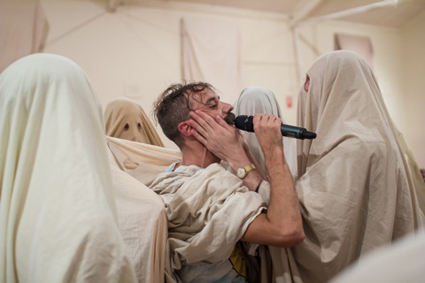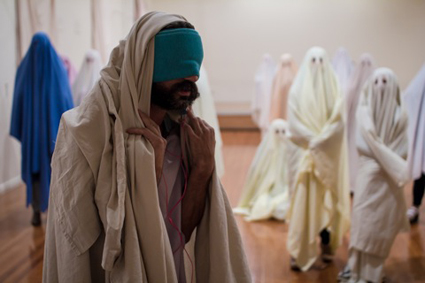A ghostly bonding
Jessica Sabatini: Luke George & collaborators, Not About Face

Luke George and collaborators, Not About Face
photo Nick Roux
Luke George and collaborators, Not About Face
I have moved in a flock—a flock of ghosts—led round an empty room by a mystical maverick. This is one memory, at least, that I can take away from Not About Face, a work to be felt and experienced rather than merely seen.
Luke George has us enter the seatless studio space draped in sheets with cut-out eyeholes, the first in a string of whimsical experiments to tweak his audience’s consciousness. Anonymity strikes as we roam, awaiting the show. “What’s under your sheet?” we wonder, our interior worlds reified, yet not revealed. (It’s a bit like a masquerade party, but we are homogenous as Halloween ghosts.) So the stuff of the spirit is raised in a literally material way—a droll device, and one that arouses doubts. What distinguishes us as we roam in these veils? How do we now ‘see’ the other? The self? And how does this change the way we inhabit the moment, our movement, and space?
You could say we’ve been given new and identical ‘bodies,’ and an involuntary flock or herd feeling is born. We shuffle about with tunnel vision and fuss with our eye holes, our sheets flow around our limbs as we move and our motions are further swayed when Luke George takes the floor.
He appears in our midst as a fellow ghost, with a hiss and a stifled shriek, then unveils himself, revealing his blindfolded face (and so, our performer is vulnerable too). “Follow me, follow me,” he urges, and we glide along, drawing back when he whirls like a dervish or strikes out a path to the wall. But what stirs the flock further still is his fitful soliloquy on the spirit and what it might mean. When the blindfold is lifted he delivers synaesthesiac speculations on the colour of our souls, and then the sounds of those colours, until he unites us all in a brief, fleeting chorus on the theme.
Such New Age allusions are rampant throughout the work, and there’s much to be said for George’s wry presentation of “aura-reading and energy-conversion” among other phenomena. He seems to have seen that there’s no escaping the kitsch, the whiff of occultism, the cultural trappings that so taint our grasp of the mystical, so he takes the whole swag and exploits and transforms it into a genre in itself. But while his treatment is exuberant and camp, he does not surrender to satire. True, he writhes and shrieks and speaks in otherworldly tongues at times, but with an air of amused demonstration and daring more than anything else.

Luke George and collaborators, Not About Face
photo Nick Roux
Luke George and collaborators, Not About Face
Overall, the work is woven by George’s sincere and lucid intent—he speaks as himself between ‘acts’—to draw our embodied presence into the moment. Is this the business of live art? Of mysticism? Of both, no doubt. But it also looks quite naturally to be the business of dance. George almost precludes remote viewing (the long-distance firing of mirror neurons at best), instead drawing us into collective engagement and (by way of experimental enactment) an inkling, yes, of the mystical.
At the highpoint of the work he invites us with feverish urgency to press his body with our hands and release into an afterglow of sensations. Then we all sink to the floor and get cosy. This is the confessional heart of the show, and the moment when we consider what reservations to suspend. “How close can we get?” George offers to swap clothes with someone in the room and “dance their dance”—an offer that I, glancing down at my lovely green dress and black boots beneath my sheet, can hardly decline.
Does he dance my dance? I would say that he does, surprisingly. And he also looks fetching in the dress, allowing the power of costume to come into play. Here again, the ‘material’ acts as an opening for the intangible—call it the spirit if you will, although style figures in this instance as well. But regardless of how we define this stuff, what Luke George aims to show is his (and therefore our) capacity to tune into one another and to connect.
So it’s only fitting that, after all this bonding, he unveils the group—with a camp rendition of a magical spell—and ends with a coda of sorts, by dancing a dance that looks authentically all his own. Taut but skittish, erratic but graceful, strutting and posing to electronic music in a wrestling singlet, it is a flamboyant display to end an absorbing work.
Not About Face, Luke George with collaborators Hillary Clark, Nick Roux, Benjamin Cisterne, Martyn Coutts, performer Luke George, Dancehouse, Melbourne, 9-13 Oct
This article first appeared as part of RT’s online e-dition 20 November, 2013
RealTime issue #118 Dec-Jan 2013 pg. 30






